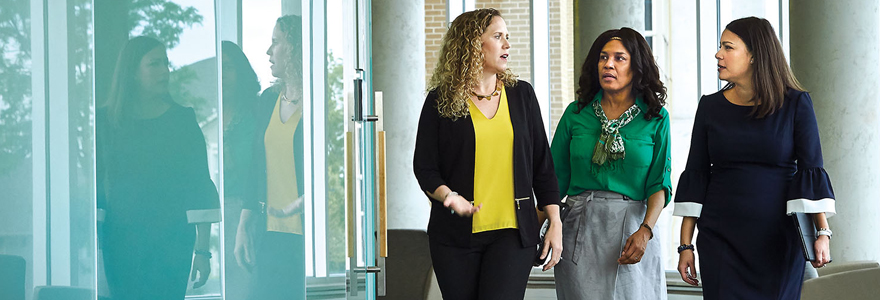The Changing Face of Leadership
The appointment of five new female physician leaders signals a new era in the Department of Paediatrics
By Jennifer Parraga, BA’93
A special passage from Bahá’í writings quickly comes to mind for Dr. Sepi Taheri as she explains her views on why balanced leadership is fundamental to success.
“The world of humanity is possessed of two wings: the male and the female. So long as these two wings are not equivalent in strength, the bird will not fly,” she explained. “Until womankind reaches the same degree as man, until she enjoys the same arena of activity, extraordinary attainment for humanity will not be realized and humanity cannot wing its way to heights of real attainment.”
A member of the Bahá’í faith, Dr. Taheri says that the core principle of the faith of equality between the sexes has helped to guide her throughout her medical education, training and practice and form a strong foundation as she navigates the challenges and opportunities of leadership.
Dr. Taheri is the Director of the Clinical Teaching Unit, the heart of Children’s Hospital at London Health Sciences Centre where most of the clinical teaching takes place for learners. She is one of five new female leaders in Paediatrics at Schulich Medicine & Dentistry and together, this fierce and focused group of women represent the changing face of leadership in the Department.
Alumna Dr. Alexandra Zorzi, MD’05, joined Dr. Taheri on the leadership team in early 2019 and serves as the Chief of Paediatric Haematology and Oncology. Clinically, she oversees the two separate services that encompass inpatients and outpatients and supports about 150 cancer patients who are on active therapy, newly diagnosed patients and those with recurring disease. She also manages a paediatric oncology survivorship clinic and cares for patients living with benign blood disorders, haemostasis and thrombosis.
It was also in early 2019 when Dr. Michelle Barton-Forbes was appointed Chief of Infectious Diseases, becoming a departmental leader. Originally from Jamaica, Dr. Barton-Forbes came to Toronto for a fellowship in infectious diseases. She ended up staying in Canada and became a faculty member at the School in 2014. Leading the growing and very busy Division of Infectious Diseases means advocating for control and prevention, as well as caring for children with severe and challenging infections from across southern Ontario and from as far north as Thunder Bay.
Dr. Roberta Berard, Chief of Rheumatology, and Dr. Tamara Van Hooren, Director of the Postgraduate
Medical Education Program, round out the team of new leaders.
 With three in every 1,000 Canadian children living with juvenile arthritis, Dr. Berard’s practice is extremely busy as she cares for her young patients with the condition, as well as children living with systemic lupus erythematosus, systemic vasculitis, autoinflammatory syndromes and juvenile dermatomyositis as well as other non-inflammatory musculoskeletal complaints.
With three in every 1,000 Canadian children living with juvenile arthritis, Dr. Berard’s practice is extremely busy as she cares for her young patients with the condition, as well as children living with systemic lupus erythematosus, systemic vasculitis, autoinflammatory syndromes and juvenile dermatomyositis as well as other non-inflammatory musculoskeletal complaints.
Dr. Van Hooren’s mixed practice focuses on inpatient hospital care and acute assessment as part of the Child Protection team. She also oversees one of the School’s largest residency programs, manages the selection of trainees, curriculum development, feedback and evaluation, and multiple accreditations.
Passionate about their patients and families, their students and residents and their research programs, the five physicians are also very enthusiastic about the potential of the leadership opportunities they have before them.
“It’s equally exciting and inspiring that we have such diverse women in leadership in paediatrics. We all have different strengths and attributes, which will help us to lead and inspire other female leaders,” Dr. Berard said.
Dr. Van Hooren agrees and says that she feels fortunate to be surrounded by other female leaders. “Many of the dialogues that other female leaders are having exist in isolation. We are doing this together,” she said.
The five leaders are also very quick to point out the uniqueness of their current leadership experience.
“There is a great sense of collegiality amongst the female leaders here and we all feel that this is a safe place to ask questions and seek mentorship; we feel incredibly fortunate to have other examples of female leaders just down the hall to which to aspire,” said Dr. Zorzi. “It’s extraordinarily unique in academia and medicine to be in this position.”
The Canadian Medical Association Journal (CMAJ) article, “Rise of women in medicine not matched by leadership roles” published in 2018, shared just how unique it is.
The article indicates that despite the fact that 41 per cent of Canadian physicians are women and 68 per cent of medical students identify as female, the proportionate rise of female leaders in the profession has yet to be seen. This is evidenced by the fact that there are only two female deans of medicine out of 17 medical schools, and a shockingly low number of female decanal leaders, departmental and divisional chairs.
While many factors reportedly contribute to this issue, the article points to just a few obstacles women face on a daily basis including male-dominated selection committees, the confidence gap between men and women, the constant criticism that female doctors lack experience due to age, and bias against females as leaders rise to the top.
Dr. Taheri has experienced her own obstacles, including bias, because of her physical stature and the fact that she is a new Canadian.
“There are biases that are expressed outwardly,” she said. “But what’s more insidious is implicit bias that is unconscious and, added to that, the underestimation of the capacity and potential of women. It directly affects how we view ourselves as leaders.”
The lack of female leadership can be isolating for those women who hold senior positions and they are often left to figure things out on their own.
Dr. Taheri suggests that a fundamental change in thinking about working patterns, schedules, environments, processes and judgment need to change if women are to be empowered to reach their potential on a societal level.
“The work model has always been tailored to a man’s way of thinking,” she said. “This hasn’t changed in centuries and it needs to be challenged.”
“Medical organizations can be more inclusive to women, and especially younger women, by accommodating childcare needs – whether that means welcoming children at evening or weekend meetings or providing childcare,” said Dr. Monika Dutt, medical officer of health and CEO of the Timiskaming Health Unit, in the CMAJ article.
Empowered by their environment and with a range of leadership styles, the five physicians are using this opportunity to make change. But Dr. Taheri warns that as a Department, they need to guard against fundamentalism in any form and encourage harmony between the divergent elements and voices.
Together, however, they are encouraged by some of the dialogues taking place and changes they are seeing across the School and hospital including the standardization of policy, exploring the discussion of productivity, welcoming children in the work environment, and creating places for female faculty to pump breast milk. They are also grateful for a supportive Department Chair/Chief, colleagues and the changes they see taking place in the School’s renewed Doctor of Medicine curriculum that put a greater focus on social medicine, diversity and inclusion.
With leadership comes great responsibility, and Drs. Taheri, Zorzi, Barton-Forbes, Berard and Van Hooren feel the responsibility in their bones.
“I feel a responsibility to inspire the next generation of young female medical leaders, and I think it’s important to be positive mentors, but we have to be honest about what leadership really means,” said Dr. Zorzi.
For Dr. Zorzi, that means being realistic about what she is able to do well and making time for self-reflection to understand her priorities and whether or not they complement each other.
“You have to stop every now and then and ask yourself, can I take this on? And what will I gain or lose if I do?” said Dr. Barton-Forbes.
Each one of these physicians is committed to mentorship, asking questions and challenging the status quo.
“It’s an exciting time in our Department; you can feel that it is a time of change,” said Dr. Berard. “We have inspiring young leaders who are working with a dynamic group of physicians and learners so we can care for our families and individually achieve our potential. The next generation will be inspired by this, and we will all be better because of it."









